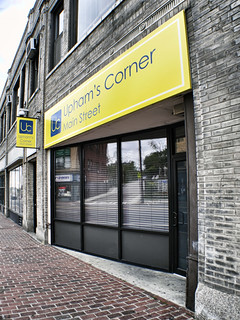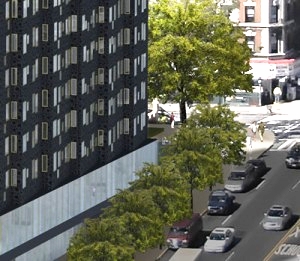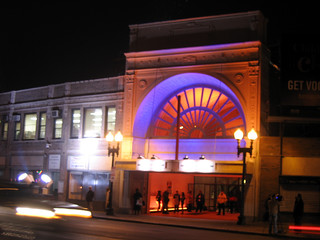National arts partnership steps up big for community revitalization

Posted June 12, 2012 at 5:04PM
An innovative and impressive partnership of philanthropic, financial, and government institutions announced today the awarding of $15.4 million in grants to support cultural initiatives to revitalize and strengthen neighborhoods, towns and cities across the country. Based in Chicago and called ArtPlace, the organization is awarding financial assistance to 47 projects in 33 communities.
ArtPlace is a national collaboration of eleven major national and regional foundations, six of the nation’s largest banks, and eight federal agencies, including the National Endowment for the Arts. According to the organization’s website, the institutions are “investing in art and culture at the heart of a portfolio of integrated strategies that can drive vibrancy and diversity so powerful that it transforms communities” with “creative placemaking.” Since its founding, ArtPlace has raised almost $50 million for the concept.
This is a substantial investment not just in the arts but also in community sustainability. The most effective antidote to the kind of sprawling outward development that has consumed our landscape, polluted our waterways and escalated harmful emissions over the past half-century is a strengthening of our existing communities. But, as I have written before, a by-the-numbers approach to smart land use or a codes-and-development approach to creating walkable urbanism may be very useful, but in themselves will not be enough to create the kinds of enriching, healthy human habitat that will be loved and will endure – that will literally be sustained - over time.  We need to aspire to more than that. A holistic approach to placemaking that includes a key role for culture – especially homegrown culture – is also essential.
We need to aspire to more than that. A holistic approach to placemaking that includes a key role for culture – especially homegrown culture – is also essential.
In addition, while federal agencies, certainly including NEA but also including the three partners in the federal communities partnership – HUD, Transportation, and EPA – have recently made remarkable contributions to help local communities meet their sustainability needs, I for one am not at all confident that sufficient federal funding will be maintained to keep those programs going at a meaningful level. We need philanthropy and the private sector to come forward. This appears to be exactly what ArtPlace is doing.
While creative placemaking isn’t going to be enough for sustainability, either, it is hard to imagine communities worth inhabiting without it. I was contacted by ArtPlace about their work last week and have only been increasingly encouraged by what I have learned since.
Here are some exciting examples of where this round of grants is going:
- Boston’s Fairmount-Indigo Line Cultural Corridor. Ninety thousand people live within walking distance of the Fairmount-Indigo rail line, their median income some 35 percent below the Massachusetts average. Two-thirds of the Boston region’s foreclosures have been along the corridor. ArtPlace is granting $480,000 to The Boston Foundation to support art installations, outdoor markets, and “random acts of culture” in the neighborhood surrounding the Uphams Corner train station in order to advance a vision for a transit-oriented “cultural corridor” that draws upon the cultural assets and ethnic traditions of the corridor’s residents.
- Collinwood Rising in Cleveland. Urbanist commentator Richard Florida, among others, has pointed to the potential of Rust Belt cities to rebrand themselves as incubators of the arts. In Cleveland, promising arts initiatives have sprung up in the Waterloo district and the Collinwood neighborhood. The websites of the Northeast Shores Development Corporation, which pursues revitalization in the area, and the organization ArtsCollinwood are full of listings for such events as an open mic night, the Waterloo Arts Festival, gallery shows by local artists, and even an appearance by the Flatlanders, the influential “more a legend than a band” that grew out of west Texas some decades ago, at the neighborhood's Beachland Ballroom. ArtPlace is awarding $500,000 to NSDC to counter urban vacancy and foreclosure in Collinwood by “working with artists to establish replicable development models for artist space in older industrial cities.”
- The Syracuse SALT District. Last year Aaron Welch and I profiled the Syracuse (NY) Art, Life and Technology district, an arts-driven revitalization that has been assisted by a LEED-ND audit and certification. The neighborhood’s vision has been guided by the local Near West Side Initiative, intended in part “to decrease energy use in homes and increase indoor air quality; help find environmentally-friendly solutions to stormwater management; promote deconstruction practices;
and create green collar jobs.” ArtPlace is granting $400,000 to the Initiative to create a “SALTquarters” arts hub, with three art studio spaces, living space for four artists, and a small gallery/exhibition space, all in a two-story, vacant and dilapidated former restaurant.
- The Hunger Cycle in Los Angeles. LA’s Cornerstone Theater Company is a multi-ethnic, ensemble-based theater company whose work “is based on the conviction that aesthetic practice is social justice, artistic expression is civic engagement, and that access to a creative forum is an essential part of the wellness and health of every individual and community.” In its very ambitious production The Hunger Cycle, the company intends to produce nine new plays over six years, exploring hunger, justice and food equity issues. Assisted by a $342,500 grant from ArtPlace, the company is engaging “low-income families with little or no access to healthy food options; migrant workers; urban and rural farmers; food distributors; supermarket workers; consumers; food justice activists; and cafeteria and food service industry workers.”
ArtPlace says its highest-ranked project in this round of grants is the Sugar Hill Children's Museum of Art & Storytelling in New York City, which will receive a $350,000 grant to develop exhibits for the future museum, a project of Broadway Housing Communities. (The facility was originally to be named for Harlem native and author/illustrator Faith Ringgold, who withdrew earlier this year.) Projected to open in early 2014, the project will be  housed in a new building along with affordable housing and an early childhood center in a historic part of Harlem where 70 percent of children are born into poor families.
housed in a new building along with affordable housing and an early childhood center in a historic part of Harlem where 70 percent of children are born into poor families.
"Through an approach we call collaborative storytelling, this museum will enable a generation of Harlem children to share their experiences of life in their neighborhood through art and storytelling, and allow others to be part of the collective experience," said Jake Barton, principal and founder of cosponsor Local Projects, in ArtPlace’s press release. Kids visiting the museum will document Harlem block by block by interviewing neighbors, painting portraits of homes and residents, and gathering these elements together into collective documentaries. Children will each get a lifetime “story space,” archiving in one place the narrative of one’s life.
That’s a concept worth rooting for.
Among the other locations where projects are receiving grants are Cumberland, Kentucky; Sitka, Alaska (among four awardees in Alaska); Phoenix; Little Rock, Arkansas; Seattle; Minneapolis (four in the Twin Cities); Philadelphia (three); Summerville, Georgia; and New Orleans (three). ArtPlace received almost 2200 letters of inquiry from organizations in 50 states, the District of Columbia, Puerto Rico, American Samoa, and the US Virgin Islands. My guess is that some locations fared particularly well because of regional interests among ArtPlace’s funders, which is understandable.
The largest grant ($1 million) will support the rehabilitation of an abandoned, six-building, two-block public school campus slated to become an arts and education center in the Tremé neighborhood of New Orleans. The facility will include 73 units of affordable live/work space for low-income artists and their families. I was also pleased to see one of my favorite initiatives, the Watts House Project, featured on ArtPlace’s website as a past recipient of ArtPlace assistance.
ArtPlace’s Tim Halbur reports that, in September, the organization will release a new set of measurements to evaluate changes over time in the people, activity and real estate value in the communities where ArtPlace has invested.
“The commitment of artists across the country to play key roles in the remaking of their communities is an extraordinary asset for revitalization,” observed Carol Coletta, director of ArtPlace, in the press release. “It is an asset that we hope every mayor, every community builder will put to work.” Before coming to ArtPlace, Coletta led some great work at the national network CEOs for Cities.
 I love it. Participating foundations in ArtPlace include Bloomberg Philanthropies, The Ford Foundation, The James Irvine Foundation, The John S. and James L. Knight Foundation, The Kresge Foundation, The McKnight Foundation, The Andrew W. Mellon Foundation, The William Penn Foundation, The Rockefeller Foundation, Rasmuson Foundation, The Robina Foundation and an anonymous donor.
I love it. Participating foundations in ArtPlace include Bloomberg Philanthropies, The Ford Foundation, The James Irvine Foundation, The John S. and James L. Knight Foundation, The Kresge Foundation, The McKnight Foundation, The Andrew W. Mellon Foundation, The William Penn Foundation, The Rockefeller Foundation, Rasmuson Foundation, The Robina Foundation and an anonymous donor.
In addition to the NEA, federal partners are the departments of Housing and Urban Development, Health and Human Services, Agriculture, Education and Transportation, along with leadership from the White House Office of Management and Budget and the Domestic Policy Council. ArtPlace is also supported by a loan fund capitalized by six major financial institutions and managed by the Nonprofit Finance Fund. Participating institutions are Bank of America, Citi, Deutsche Bank, Chase, MetLife and Morgan Stanley.
A complete list of this year’s ArtPlace awards can be found on the organization’s website.
Related posts:
- Preserving a sense of place in LA's Little Tokyo (April 9, 2012)
- People Habitat: great city places (November 7, 2011)
- The role of the arts in thriving communities (July 28, 2011)
- The importance of place to sustainability (July 12, 2011)
- Ambitious, revitalizing arts district goes green in Syracuse (February 9, 2011)
- Arts-driven revitalization in Kentucky - yes, Kentucky (December 17, 2010)
Move your cursor over the images for credit information.
Please also visit NRDC’s Sustainable Communities Video Channel.


